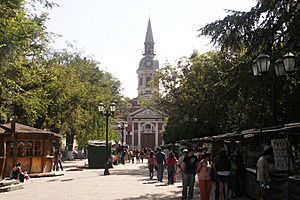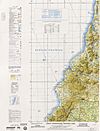Constitución, Chile facts for kids
Quick facts for kids
Constitución
|
|||||
|---|---|---|---|---|---|
 |
|||||
|
|||||
| Country | Chile | ||||
| Region | Maule | ||||
| Province | Talca | ||||
| Founded | 1794 | ||||
| Government | |||||
| • Type | Municipality | ||||
| Area | |||||
| • Total | 1,343.6 km2 (518.8 sq mi) | ||||
| Elevation | 75 m (246 ft) | ||||
| Population
(2012 Census)
|
|||||
| • Total | 41,207 | ||||
| • Density | 30.6691/km2 (79.433/sq mi) | ||||
| • Urban | 37,202 | ||||
| • Rural | 8,879 | ||||
| Demonym(s) | Maulino/a | ||||
| Sex | |||||
| • Men | 23,389 | ||||
| • Women | 22,692 | ||||
| Time zone | UTC-4 (CLT) | ||||
| • Summer (DST) | UTC-3 (CLST) | ||||
| Area code(s) | 56 + 71 | ||||
Constitución (pronounced kon-stee-too-SYON) is a city and a special area called a commune in the Talca Province of the Maule Region in Chile. It used to be a very popular place for people to visit by the sea. However, as industries like paper and wood pulp grew, fewer tourists came. Today, Constitución is a smaller port city in Chile.
Contents
History
Before the Spanish arrived, the area where Constitución now stands was home to the Chango people and the Mapuche tribe. Both groups used the area for fishing and lived there during certain seasons. When Spanish explorers came, they used this spot as a port for their large ships, called galleons, and other trading vessels. These ships sailed to different parts of South America and other ports in the Pacific Ocean.
Nueva Bilbao
Many people tried to start a lasting settlement in the area. But it was Santiago Oñederra who first succeeded around 1791. Oñederra suggested founding the settlement to the Chilean government. Governor Ambrosio O'Higgins approved the idea in 1794. The settlement was first named New Bilbao (Nueva Bilbao). It was named after a city in Northern Spain called Bilbao, which is in the Basque region.
Renaming to Constitución
In 1828, New Bilbao was given a new name: Constitución. On August 4, 1828, the Chilean Congress agreed to make Constitución a major port. Four days later, Vice President Jose Antonio Pinto signed the official order. From 1828 onwards, Constitución became part of the Maule Region. Later, it was also included in the Talca Province.
21st century
On February 27, 2010, a very strong earthquake (8.8 magnitude) hit Chile. After the earthquake, a large tsunami struck Constitución. About 350 people in the city sadly died from the tsunami. Luckily, two weeks before the earthquake, local people had practiced what to do. They learned to go to higher ground if they couldn't stand during a tremor, because a tsunami might follow. The tsunami waves were estimated to be about 15 meters (50 feet) high.
A brave fisherman named Pedro Muñoz helped many people. He used his small boat to rescue people who were celebrating the end of summer on an island in the Maule River. He made two trips, bringing people safely to the riverbank. On his third trip, a huge tsunami wave sadly swept over his boat, and he was lost.
The earthquake and tsunami caused a lot of damage to Constitución. It was impossible to get electricity back on right away because of how much the tsunami had damaged the city.
Geography
The city's economy and landscape are greatly influenced by a large factory. This factory, called Celulosa Arauco y Constitución, makes cellulose, which is used for paper. The company has faced some legal issues regarding pollution in the local environment. The areas around the city are mostly covered by artificial forests of eucalyptus and pinewood trees. Some people worry that these forests harm the natural homes of local animals and make the soil acidic and less fertile.
Climate
| Climate data for Constitución | |||||||||||||
|---|---|---|---|---|---|---|---|---|---|---|---|---|---|
| Month | Jan | Feb | Mar | Apr | May | Jun | Jul | Aug | Sep | Oct | Nov | Dec | Year |
| Mean daily maximum °C (°F) | 22.9 (73.2) |
22.2 (72.0) |
21.1 (70.0) |
18.9 (66.0) |
16.4 (61.5) |
14.7 (58.5) |
14.4 (57.9) |
14.9 (58.8) |
16.3 (61.3) |
17.7 (63.9) |
19.9 (67.8) |
21.3 (70.3) |
18.4 (65.1) |
| Daily mean °C (°F) | 17.6 (63.7) |
16.8 (62.2) |
15.5 (59.9) |
13.5 (56.3) |
12.1 (53.8) |
10.6 (51.1) |
9.9 (49.8) |
10.2 (50.4) |
11.2 (52.2) |
12.9 (55.2) |
14.7 (58.5) |
16.6 (61.9) |
13.5 (56.3) |
| Mean daily minimum °C (°F) | 11.4 (52.5) |
11.5 (52.7) |
10.3 (50.5) |
8.7 (47.7) |
8.1 (46.6) |
6.9 (44.4) |
6.1 (43.0) |
6.2 (43.2) |
7.1 (44.8) |
8.2 (46.8) |
9.9 (49.8) |
11.1 (52.0) |
8.8 (47.8) |
| Average precipitation mm (inches) | 7.8 (0.31) |
7.8 (0.31) |
16.0 (0.63) |
51.6 (2.03) |
162.0 (6.38) |
205.0 (8.07) |
174.5 (6.87) |
124.4 (4.90) |
69.6 (2.74) |
36.6 (1.44) |
21.6 (0.85) |
17.6 (0.69) |
894.5 (35.22) |
| Source: Meteorología Interactiva | |||||||||||||
Demographics
According to a census taken in 2002 by the National Statistics Institute, Constitución covers an area of about 1,343.6 square kilometers (518.8 square miles). It has 46,081 people living there. This includes 23,389 men and 22,692 women. Most of these people, about 37,202 (80.7%), live in urban areas (cities and towns). The rest, 8,879 (19.3%), live in rural areas (the countryside). The population of Constitución grew by 14.2% between 1992 and 2002.
Administration
Constitución is a "commune," which is a local government area in Chile. It is managed by a municipal council. The leader of this council is called an alcalde (mayor), who is chosen by voters every four years. The current mayor is Fabián Perez.
Constitución is part of a larger area for elections. Its representatives in the Chamber of Deputies (a part of Chile's government) are Pablo Lorenzini and Pedro Pablo Alvarez-Salamanca. In the Senate, the representatives are Juan Antonio Coloma Correa and Andrés Zaldívar Larraín.
The company Celulosa Arauco y Constitución helps fund many social and economic projects in Constitución. This provides important money for the local government. However, some people worry that this financial help might make it harder for the local government to question the company about pollution issues.
Economy
The Maule region, where Constitución is located, has one of the lowest average incomes per person in Chile. The main ways people earn money in Constitución are through fishing, farming, forestry, and making small handmade goods.
One of the biggest employers in the city is Celulosa Arauco y Constitución. This company works with wood pulp, engineered wood, and forestry. In 2006, despite some lawsuits and protests, the company was allowed to release certain substances from its plant into the sea. In 2010, the earthquake and tsunami caused the plant to close for three months because of power outages and damage.
Transportation
Railways first came to the Maule Region in mid-1889. The first train service began on August 13, 1892, connecting Talca and Curtiduría. The next part of the railway reached Pichamán on November 1, 1894. Tracks were built along the northern side of the Maule River, across from Constitución. Constitución's first train station opened in 1902. A new station was built in 1915.
Constitución is the last stop for the Ramal de Maule train, also known as the Ramal Talca-Constitución. This is a special rural train that travels about 80 kilometers (50 miles) from Talca. The train ride is very scenic, offering views of the Andes mountains and the Pacific Ocean. Today, this train line is not used as much and might even close. In the late 1800s, trains were the main way to travel in Chile. But in recent times, most Chileans prefer to travel by bus or in private cars. Because of this change, passenger train travel has become less common.
The city also has an airport called Quivolgo International Airport.
Images for kids
See also
 In Spanish: Constitución (Chile) para niños
In Spanish: Constitución (Chile) para niños







